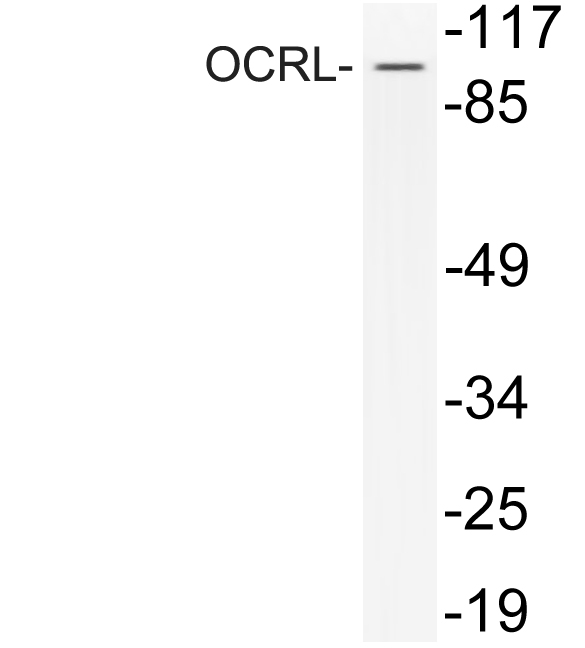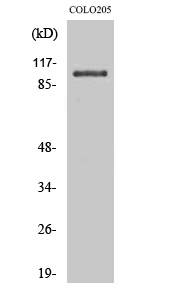产品名称
OCRL Rabbit Polyclonal Antibody
别名
OCRL; INPP5F; OCRL1; Inositol polyphosphate 5-phosphatase OCRL-1; Lowe oculocerebrorenal syndrome protein
蛋白名称
Inositol polyphosphate 5-phosphatase OCRL-1
存储缓冲液
Liquid in PBS containing 50% glycerol, 0.5% BSA and 0.02% New type preservative N.
Human Gene Link
http://www.ncbi.nlm.nih.gov/sites/entrez?db=gene&term=4952
Human Swissprot No.
Q01968
Human Swissprot Link
http://www.uniprot.org/uniprotkb/Q01968/entry
免疫原
The antiserum was produced against synthesized peptide derived from human OCRL. AA range:150-199
特异性
OCRL Polyclonal Antibody detects endogenous levels of OCRL protein.
稀释度
WB 1:500 - 1:2000. ELISA: 1:10000. Not yet tested in other applications.
宿主
Polyclonal, Rabbit,IgG
背景介绍
This gene encodes an inositol polyphosphate 5-phosphatase. This protein is involved in regulating membrane trafficking and is located in numerous subcellular locations including the trans-Golgi network, clathrin-coated vesicles and, endosomes and the plasma membrane. This protein may also play a role in primary cilium formation. Mutations in this gene cause oculocerebrorenal syndrome of Lowe and also Dent disease. Alternate splicing results in multiple transcript variants. [provided by RefSeq, Jan 2016],
组织表达
Brain, skeletal muscle, heart, kidney, lung, placenta and fibroblasts. Expressed in the retina and the retinal pigment epithelium.
细胞定位
Cytoplasmic vesicle, phagosome membrane . Early endosome membrane . Membrane, clathrin-coated pit . Cell projection, cilium, photoreceptor outer segment . Cell projection, cilium . Cytoplasmic vesicle . Endosome . Golgi apparatus, trans-Golgi network . Lysosome . Also found on macropinosomes (PubMed:25869668). Colocalized with APPL1 on phagosomes (PubMed:22072788). .
信号通路
Inositol phosphate metabolism;Phosphatidylinositol signaling system;
功能
catalytic activity:1-phosphatidyl-1D-myo-inositol 4,5-bisphosphate + H(2)O = 1-phosphatidyl-1D-myo-inositol 4-phosphate + phosphate.,caution:It is uncertain whether Met-1, Met-18 or Met-20 is the initiator.,disease:Defects in OCRL are the cause of Dent disease type 2 (DD2) [MIM:300555]. DD2 is a renal disease belonging to the 'Dent disease complex', a group of disorders characterized by proximal renal tubular defect, hypercalciuria, nephrocalcinosis, and renal insufficiency. The spectrum of phenotypic features is remarkably similar in the various disorders, except for differences in the severity of bone deformities and renal impairment. Characteristic abnormalities include low-molecular-weight proteinuria and other features of Fanconi syndrome, such as glycosuria, aminoaciduria, and phosphaturia, but typically do not include proximal renal tubular acidosis. Progressive renal failure is common, as are nephrocalcinosis and kidney stones.,disease:Defects in OCRL are the cause of Lowe syndrome [MIM:309000]; also known as Lowe oculocerebrorenal syndrome. The Lowe syndrome is an X-linked multisystem disorder affecting eyes, nervous system, and kidney. It is characterized by hydrophthalmia, cataract, mental retardation, vitamin D-resistant rickets, aminoaciduria, and reduced ammonia production by the kidney. Ocular abnormalities include cataract, glaucoma, microphthalmos, and decreased visual acuity. Developmental delay, hypotonia, behavior abnormalities, and areflexia are also present. Renal tubular involvement is characterized by impaired reabsorption of bicarbonate, amino acids, and phosphate. Musculoskeletal abnormalities such as joint hypermobility, dislocated hips, and fractures may develop as consequences of renal tubular acidosis and hypophosphatemia. Cataract is the only significant manifestation in carriers and is detected by slit-lamp examination.,function:Converts phosphatidylinositol 4,5-bisphosphate to phosphatidylinositol 4-phosphate. Also converts inositol 1,4,5-trisphosphate to inositol 1,4-bisphosphate and inositol 1,3,4,5-tetrakisphosphate to inositol 1,3,4-trisphosphate. May function in lysosomal membrane trafficking by regulating the specific pool of phosphatidylinositol 4,5-bisphosphate that is associated with lysosomes.,similarity:Belongs to the inositol-1,4,5-trisphosphate 5-phosphatase type II family.,similarity:Contains 1 Rho-GAP domain.,tissue specificity:Brain, skeletal muscle, heart, kidney, lung, placenta and fibroblasts.,
纯化
The antibody was affinity-purified from rabbit antiserum by affinity-chromatography using epitope-specific immunogen.


